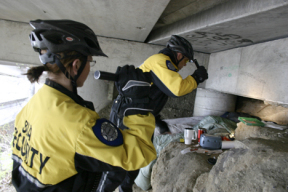Two decades after its creation, and on the eve of the City Council’s vote to continue its existence, the Business Improvement Area is poised to make a handful of changes aimed to expand its services to downtown residents and property owners, according to a presentation yesterday at City Hall.
The BIA, an 84-block area of downtown Tacoma that provides security, maintenance, and marketing services for the district’s property owners, was created in the spring of 1988, after a petition from a majority of downtown property owners led City Council to approve an ordinance that opened the door for the BIA to legally form. That ordinance faces a renewal every 10 years: it was re-upped in 1998, and councilmembers last night heard the first reading of an ordinance to continue the BIA through April 2018. A majority of property owners support the BIA, and Council is expected to approve the ordinance next week and renew the program.
According to BIA operations director Paul Ellis, who briefed members of the City Council’s community and economic development committee yesterday afternoon, the board recently agreed to consider expanding the BIA’s 84-block area if property owners were to petition for its services in their area. Historically, the BIA’s boundary has remained static over the past 20 years.
Ellis also said the BIA is negotiating with City Manager Eric Anderson and Pierce Transit officials to add three to four Tacoma Police officers to patrol the area, particularly near South Ninth and Commerce Street, which is a hub for public transit. The BIA has pledged to commit $95,000 per year to a police fund to pay for the additional officers.
The BIA’s revenue base comes from assessments of property owners who fall into two categories. One category, largely office space property owners, are charged approximately 10.5 cents per square foot. Another category, consistently mostly of residents, non-profits, surface parking lots, and buildings untenable, are charged approximately six cents per square foot. However, according to Ellis, downtown condominium associations recently agreed that residents will be shifted into the higher-rate category along with office space property owners.
Today, the BIA’s most visible presence to downtown visitors is a team of 10 bike patrol officers who cover the area. Though they aren’t law enforcement officers, BIA security officers have been credited with defusing many nuisance situations — sleeping in parks and public places (231 incidents in 2006, according to BIA statistics), drinking in public (145 incidents), and property damage (211 incidents).
On eve of 10-year renewal, changes ahead for downtown BIA








